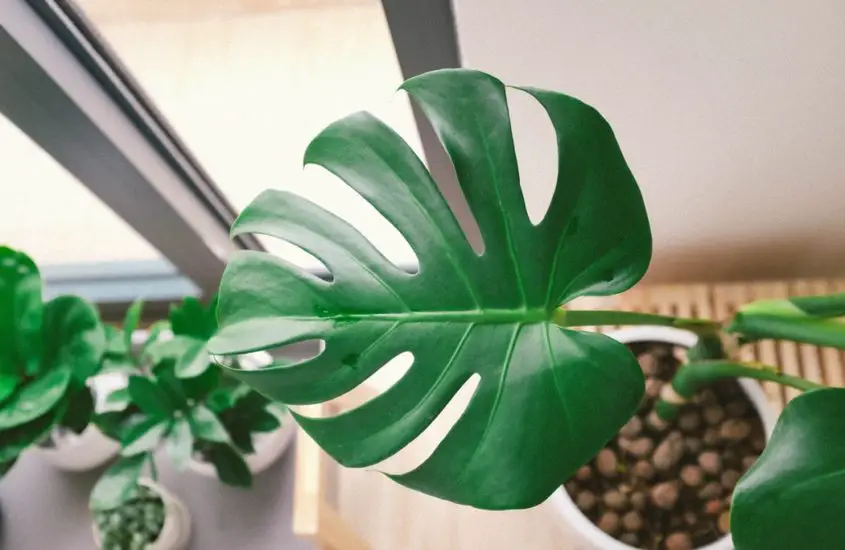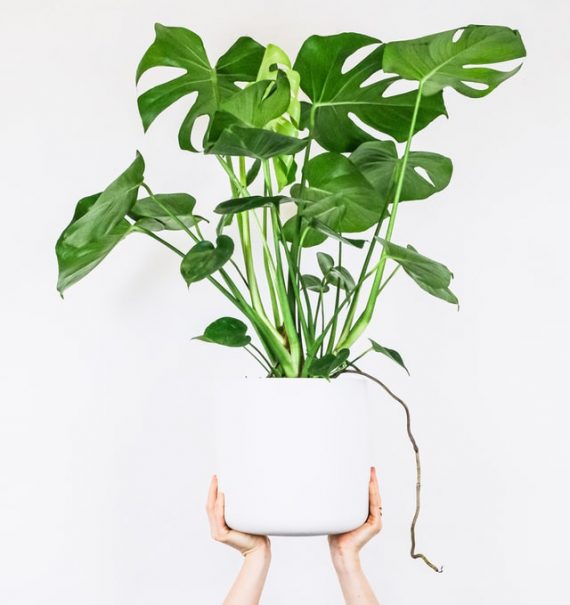Monstera Aerial Roots: What To Do With Them

Welcome to my updated article about Monstera aerial roots. Below I’ll discuss why they grow and what to do with them.
But first, let me explain what Monstera aerial roots are to begin with.
What are Monstera Aerial Roots?
Most plants grow roots under the soil’s surface. But some climbing plants, like the Monstera, also grow roots above the surface. These are called aerial roots.
They serve various functions and play a role in the way the plant grows and gets sunlight and moisture.
Why Do Monstera Grow Aerial Roots?
Monstera plants belong to the epiphyte family. This means they grow upward towards the light using other plants, like trees, for support.
The roots help them grip on to surfaces so they can climb.
They also provide access to sunlight which is much needed in their dense rainforest natural habitat.
Aerial roots absorb moisture from the air and the surfaces around them.
This works as a supplement to the water they are getting from underground sources.
What’s the Difference Between Aerial Roots and Underground Roots?
The most obvious difference between aerial and underground roots is that underground roots grow underground while aerial roots grow above ground.
But there is also a functional difference.
Underground roots absorb nutrients from the soil providing sustenance to the entire plant.
While aerial roots get nutrients and water from the sun and air, their main purpose is to support the plant as it climbs.
What Do Aerial Roots Look Like?

Aerial roots grow from the nodes of your plants.
Young roots will look like little bumps that grow into green branches.
Older roots will be brown and woody.
The roots can grow quite long, and they can pop up on different spots of your plant.
If they grow indoors, they can grow up your walls and furniture which can cause damage so it’s wise to keep them under control.
Should I Cut the Aerial Roots Off My Monstera?
No, you should not cut the aerial roots off your Monstera. Doing so will keep their leaves from growing to their full size.
It will also open the plant up to bacteria, fungus and other diseases, especially if you use dirty tools for trimming.
Cutting off the roots also takes away all the benefits they provide to the plant.
They can no longer be used for support or to provide access to moisture and sunlight.
How to Trim Monstera Aerial Roots
While it’s not a good idea to cut the aerial roots of your monstera, you can trim them if they are getting out of hand.
To do this, you must use sterilized tools. That way you won’t run the risk of exposing the plant to fungi, bacteria or viruses.
You can sterilize your tools by cleaning them with alcohol or hydrogen peroxide.
Trim the roots back to the stem cutting in the area in front of where the root meets the stem.
Avoid cutting too close as this will also increase the risk of your plant becoming infected.
Make sure to remove the entire root and not just part of it.
If you would like the root to grow back into the soil, let it callous over for a couple of days to allow it to dry out and to prevent rot.
Keep in mind that trimming aerial roots will stimulate their growth.
Therefore, it’s best to trim in the late summer and early fall after the height of growing season.
Trimming the roots will also stunt the growth of your plant so it may not be ideal if you are aiming to grow a large plant.
Other Things to Do with Aerial Roots
If you would prefer not to cut your monstera’s aerial roots, there are other things you can do with them.
Here are some examples.
Get a Trellis or Moss Pole: A trellis or moss pole will give your monstera something to grip onto so its roots don’t extend into open space.
Simply plant the trellis near your plant and tie the stems to it to encourage the monstera to grow onto the trellis.
It’s best to use a pole that’s slightly taller than the plant so it has room to grow before you need to trim it or get a taller support.
The biggest drawback of a trellis or moss pole is that it can make it difficult to repot the plant.
However, repotting only needs to happen every other year and your plant will appreciate the support the trellis provides.
Leave Them Be: If the aerial roots don’t bother you, you can leave them as is. Simply tuck them into the pot to get them out of the way if desired.
While some may try to plant aerial roots in soil, this is not recommended. They do not absorb moisture well and will probably end up rotting.
Do Aerial Roots Need Moisture?
Aerial roots get all the moisture they need from the air so it’s not necessary to give them extra water.
In fact, if you put aerial roots in water, they will start rotting.
If your monstera plant is growing indoors and the air in your home is particularly dry, you can gently mist it once a week.
It’s best to mist it in the morning so it’s dry by the evening.
Can I Grow a New Monstera from Aerial Roots?
No, you cannot grow a new monstera plant from aerial roots.
Growing a new plant will require a node, or a part of a plant stem from which two or more leaves emerge.
You may be able to root a leaf cutting without a node, but it will only produce a plant if the node is present.
It’s a good idea to include an aerial root with your cutting because then you will be guaranteed to have a node, but if you get only the node, that should do it.
There may be instances where people were able to produce plants from aerial roots alone, but that’s not the norm.
Monstera Aerial Roots – Conclusion
A monstera’s aerial roots serve an essential purpose but if they grow too long, they can do damage to their surroundings.
The tips in this article will help you determine the best way to deal with them – I hope you’ve enjoyed reading this article and found it helpful.
Here are some related articles you may also enjoy:
How to De-Head Daisies
Rosemary Plant Care

About The Author: Hi, I’m Jessica. I’m a Mom of 2 and I love DIY hacks, home decor ideas and non-toxic cleaning tips. I created this website to share my knowledge with a community of like-minded people who love simple, easy and safe ways to keep their home clean and inspiring. I hope you enjoy!








